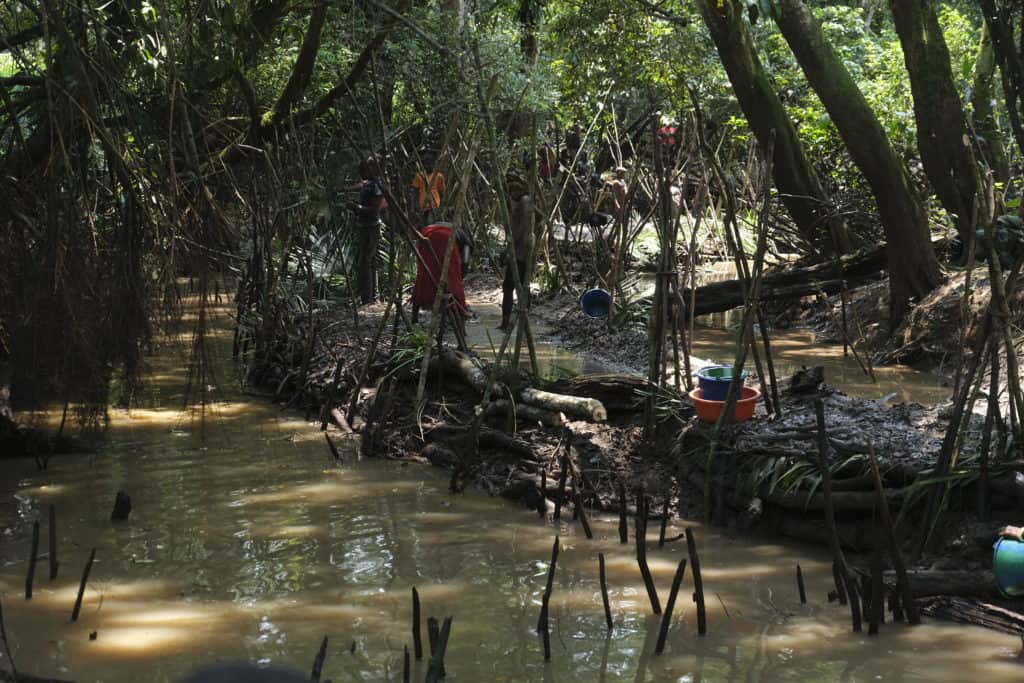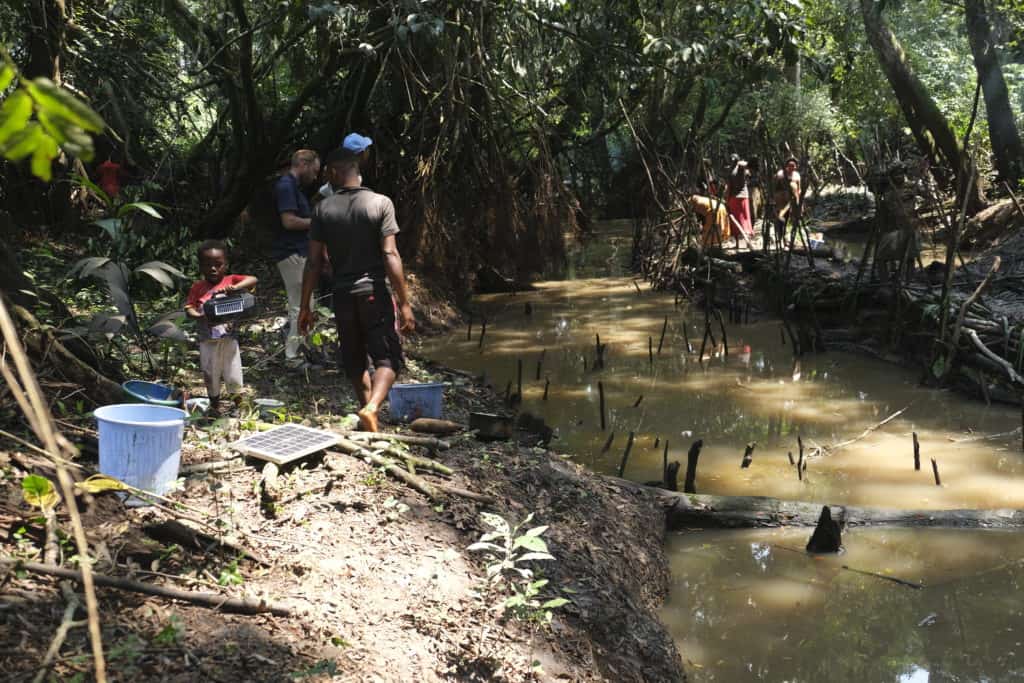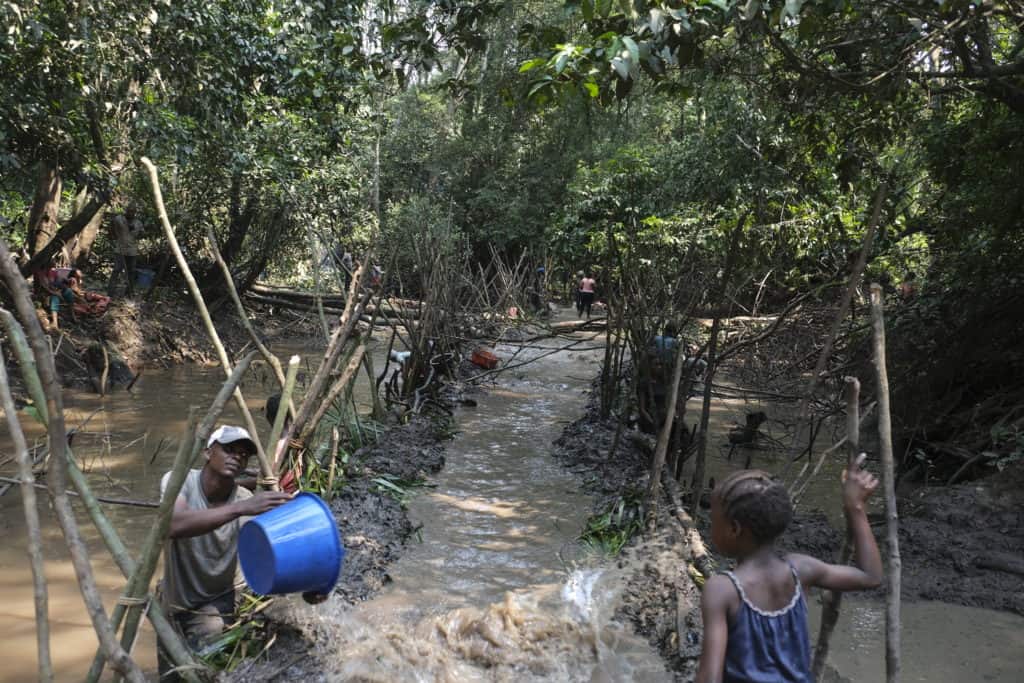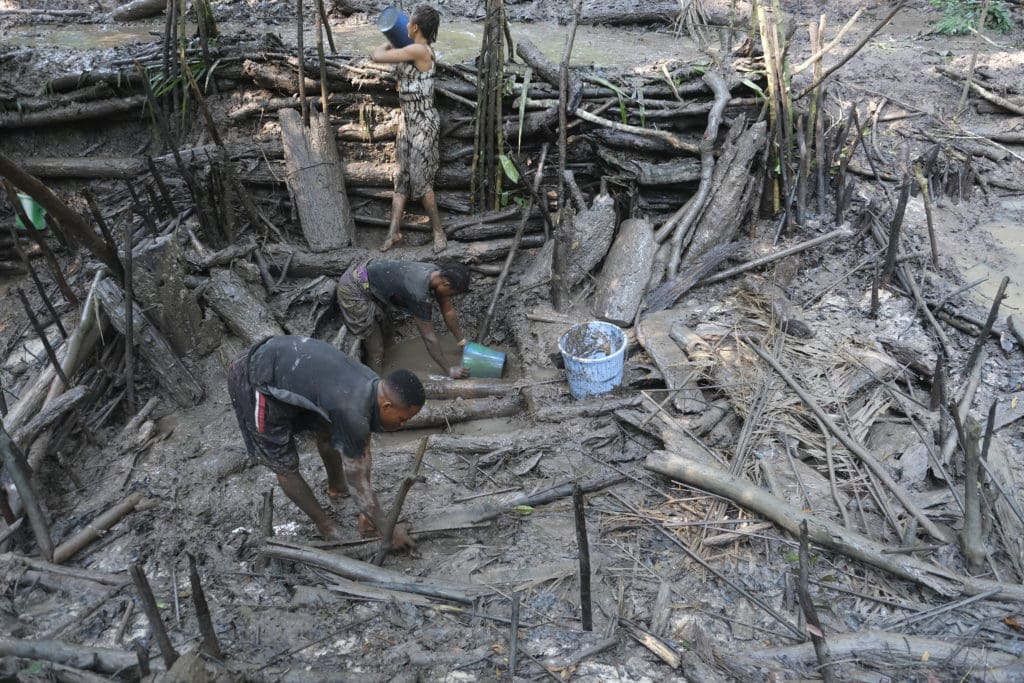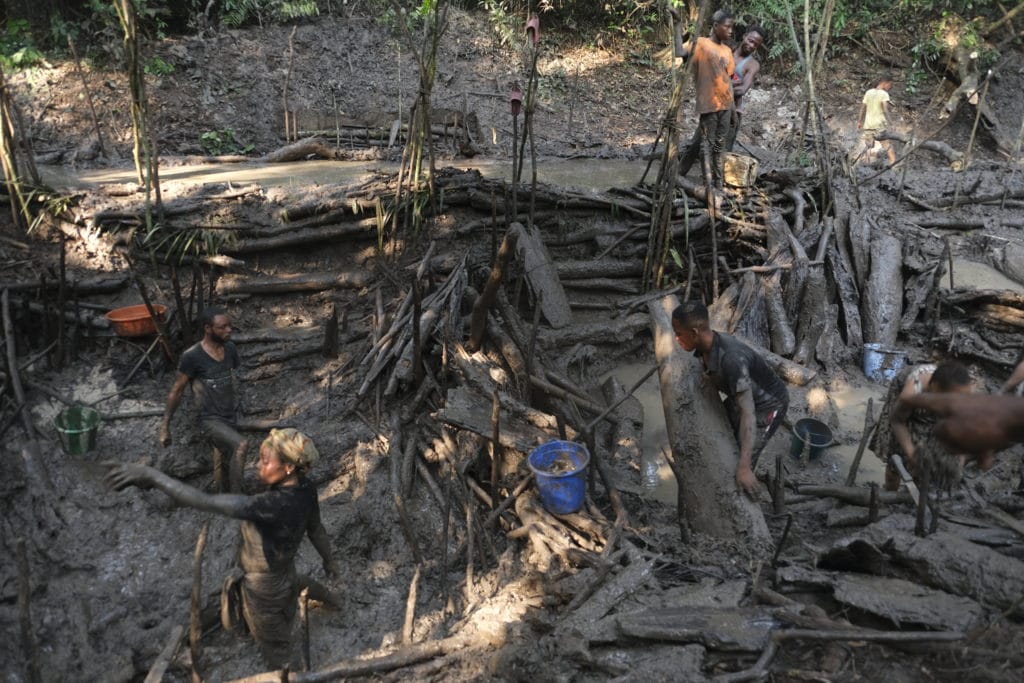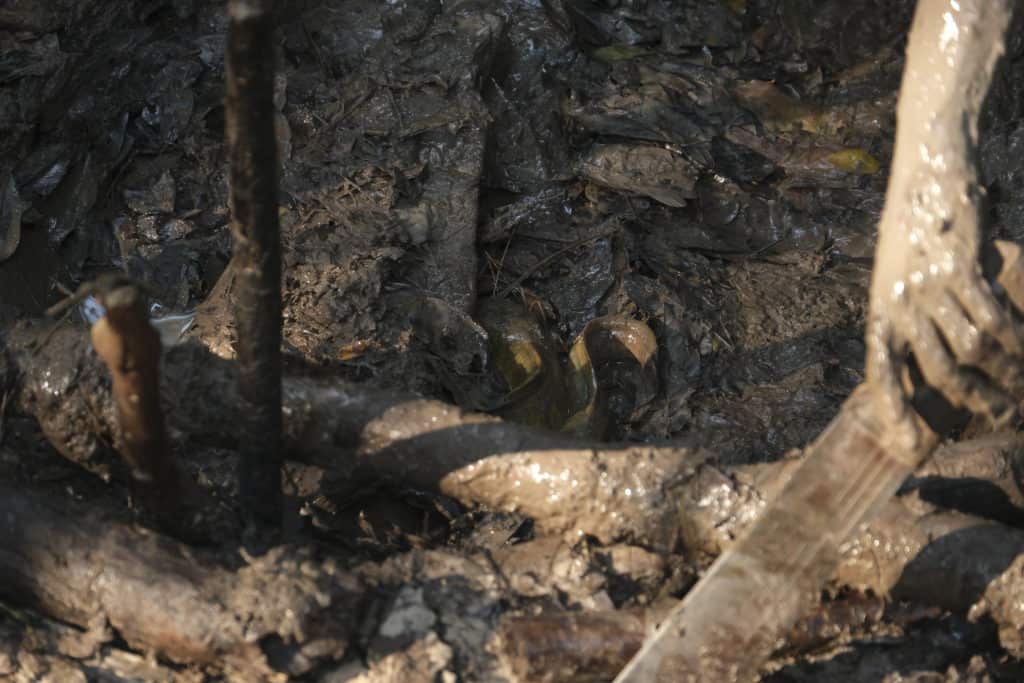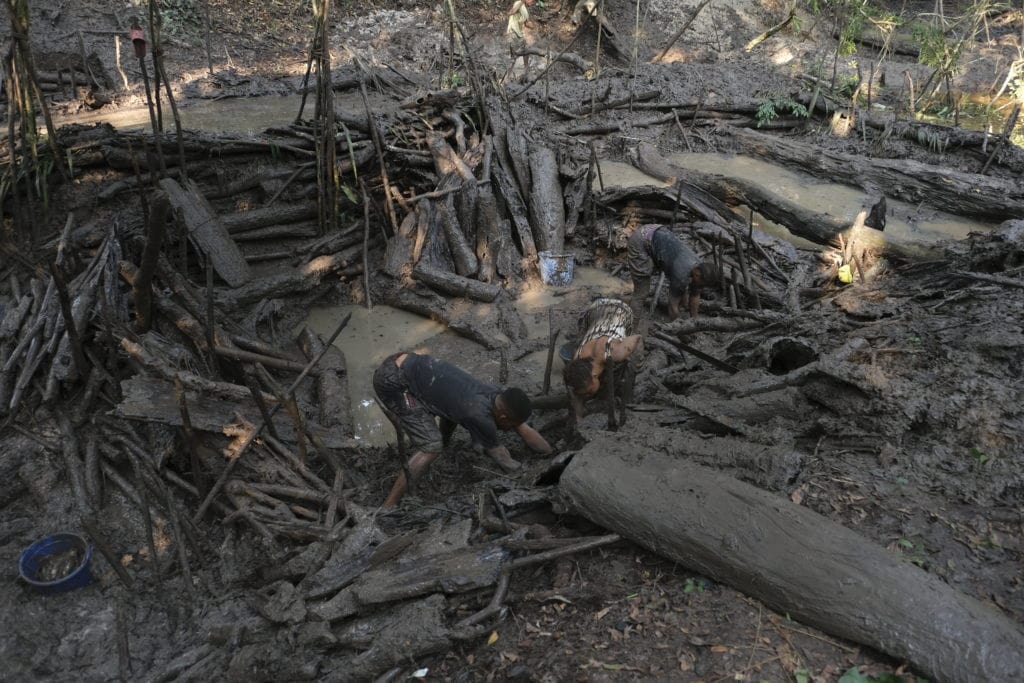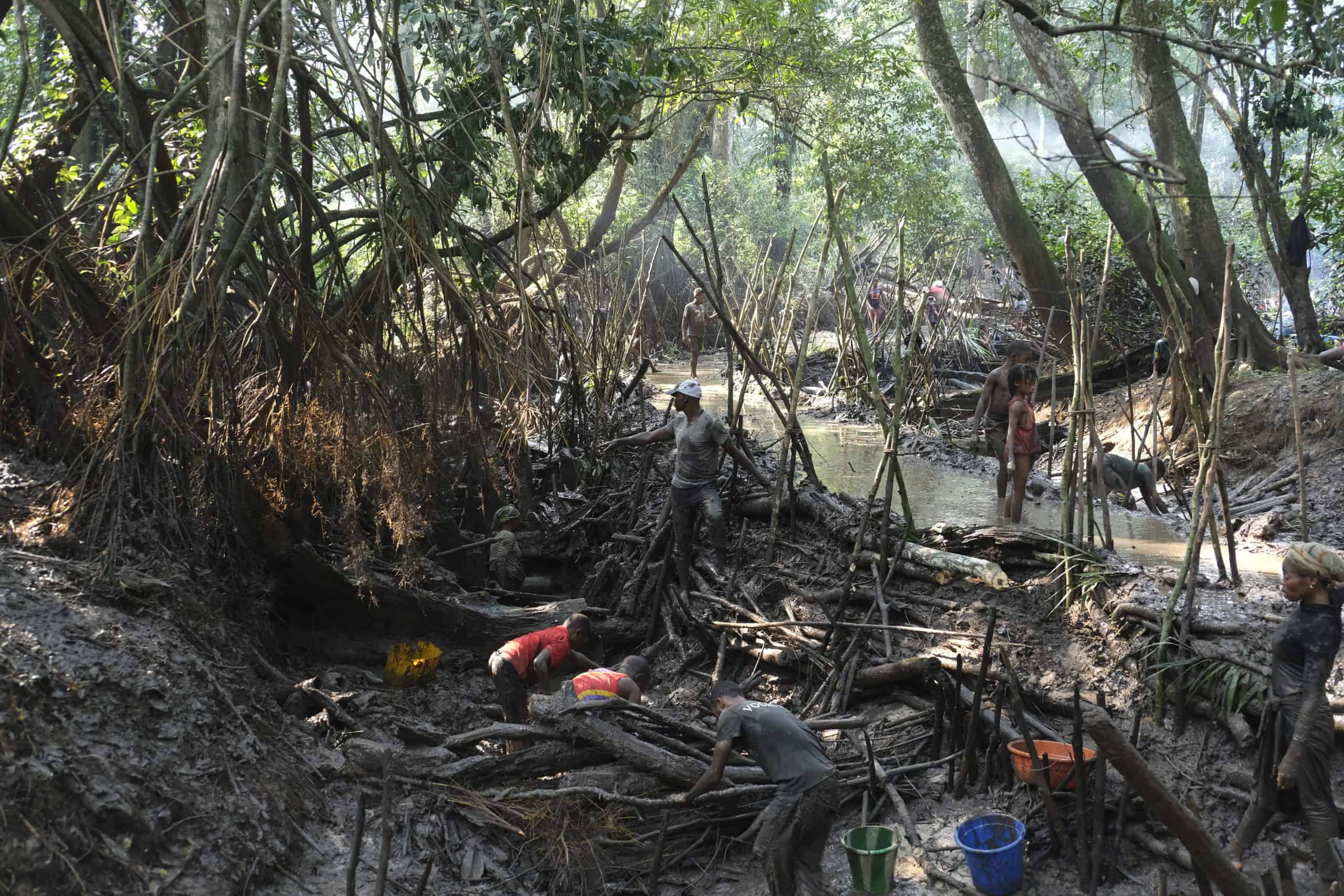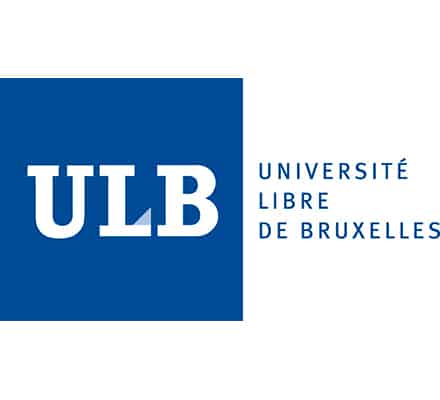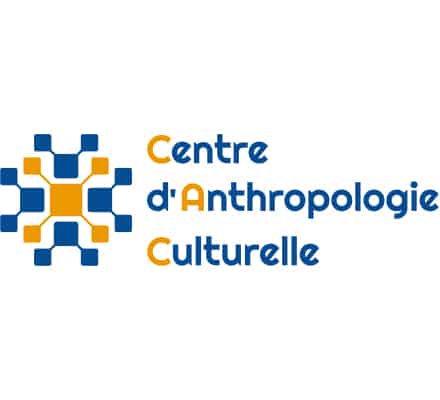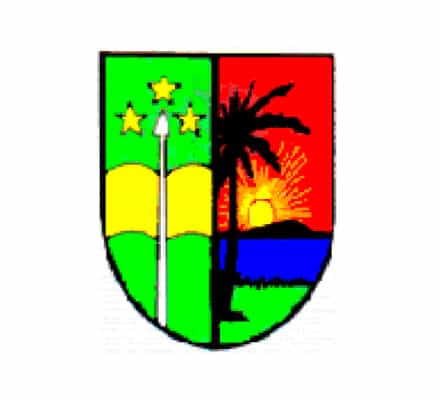* names with an asterisk are pseudonyms
We arrive at the nganda (fishing camp) of Likau around 9.30 am, together with Michel (the commander of our speedboat), Peter and Emmanuel (researchers), Jean* (chef d’avenue from Lombo, Opala) and Faustin*, the son of nkumu (chief) Papy Lienge. The nganda (fishing camp) of Likau is a permanent outpost of the village of Yasomba (found downstream, on the opposite bank) and is located on the outside of a large bend in the Lomami River, about 25 km downstream from the territorial centre of Opala. In the low water season (elanga), the camp is high up on the river bank, overlooking the river by four to five metres. On the opposite side is the forest, which is flooded most of the year, but is now at its lowest water level.



About eight dugout canoes (bwátu) are already there, on the other side. Faustin says: “They have already crossed, they have already started”. We line up right where the other canoes are and head into the forest at the mouth of the small stream whose name, Likau, gives its name to the fishing camp opposite. Where the Likau flows into the Lomami can be seen from a wooden dam (lokando in Ngoyagoya, the local variant of the KiMbole language). The lokando lets the water through, but not the fish. Originally, this year’s kopepa (scoop fishing) was supposed to happen yesterday, but there was a huge wasp nest in a tree above the small stream that had to be burnt before the event. With this done, today everyone has come for this quasi-yearly ritual, as kopepa, scoop fishing, is also an important social institution.
At first, I don’t really understand who is doing what: some youngsters are bringing wooden sticks and palm branches (mandalala); others are digging up the the central dike with a machete (mbéli), moving the earth to the side so as to fortify the flanks of the elevated channel. Smoke rises from little fires under the trees to prepare snacks and calories for the upcoming working day. I am reminded of the scout gatherings we had when I was a kid in Belgium. We follow the little path to where three days ago Faustin, Jean-Michel and Jean had shown us how to fish with rods and makendi (line and hook). This is the upper end of the community river section that reaches down to the estuary at about 500m. Scooping out this amount of water can only be done in a collective effort.
Chief Papy approaches and explains: “each couple here who belongs to our lineage and kind owns a small stretch of our river here, a lopango (compound), which is a section reserved for them and to which they return every year.” The couples are those of Papy’s sons, i.e. their wives who, in the virilocal tradition, come from elsewhere. But also his sisters with their husbands as well as his daughters, who, married elsewhere, have returned to their home for this special occasion. Beyond the catching of fish for protein, kopepa is clearly also a special occasion to reaffirm one’s belonging to the family. Somehow I am reminded of what Christmas in Belgium and in Germany has become.
I ask what the sticks are called, that are rammed vertically into the ground and tied together to form an X, stabilising the central dam. Called sío, these lateral reinforcements are renewed each year, and I start to understand that this dam must surely be several generations old. “It is not all too old”, says Papy. “It’s my father who started it in 1932. Before, everything was flat here.” We learn that the dam in the middle dates back to 1932, when the colonial administrator of Opala had issued a document to chief Papy’s father, guaranteeing him and his lineage access to the stream and the surrounding forest. This had happened after a conflict over fishing grounds had divided his father from his own expanding lineage.
A boy approaches the chief and asks him where his lopango is. “This is my nephew”, Papy explains. “He has come with his mother, who is my sister. There’s not much room left here, but I have to fit him in somewhere. So I gave him one of the unfinished compounds nearby.” This lets him participate, but also prevents him from weighing on the yield of fish in the old family section of the water. Clearly, with Papy having 5 wives and 29 children, and the family growing all the time, the social and demographic pressure here is real. It’s likely that one of his sons will soon decide to move away to find and found his own kopepa plot.
Faustin went further upstream with one of the two shovels. He’s gone to build a big dam (ngúka), so that the scooping can finally begin. In front of us, Christelle* is up to her chest in water. Christelle is the wife of Jean-Michel, another one of Papy’s sons, and Madeleine* is his younger sister. With no additional lopango available, they have decided to share the one in front of us, half the fish found for Christelle, the other half for Madeleine.
Christelle pours the first bucket full of 10 litres of river water over the dam. As the water flows towards the others, everyone is now urged to hurry up and finish sealing the dam. Papy’s older sister comes by and says: “Oh my God, there’s so much water! We’ll never make it today!” The seasons are disrupted these days, it seems: there is much more water than usual. Last year’s session of scooping had to be cancelled: too much water! But such perturbations, though more intense this year than before, have happened in the past, it is not something really new. I hear the sound of another bucket of water being poured further downstream. Slowly and steadily, everything gets under way: Madeleine and Christelle scoop water in sync. A dozen buckets, then a pause. There’s constant laughter and giggles, including from the boys, who watch as we do from the shore. “Kopepa is a girls’ thing”, one of Papy’s daughters had told me, not without a certain pride. The boys only come into play later, when, after emptying the riverbed, it’s time to catch, or collect, fish, and rearrange the underwater architecture.
In the lopango next door Marie-Jeanne*, the wife of Papy’s eldest son, is busy scooping. She is considerably older than Christelle and Madeleine, is scooping alone and does not talk or laugh as she works. To our right, the working mood is cheerful and exuberant; on the other side, it’s stern and serious. Is this mood and concentration part of effective scoop-fishing? Jean-Michel has entered the riverbed and is helping his wife and sister now remove the countless panukula, the plank-like pieces of wood under which catfish (ngólo) like to hide. He lifts a piece of an old canoe out of the mud, which he had placed there during the last kopepa action two years ago. Numerous pieces of hollowed-out bamboo are lifted up. Almost every piece that appears reveals a ngólo or a mungúsu fish, whose heads are crushed with nonchalance by a stoke of a machete. Also to our left, Marie-Jeanne receives help from her husband now, the chief’s eldest son. As the water level drops and more and more layers of wood are removed, it becomes clear that, although there are fewer of them here than in their neighbours’ compound, Marie-Jeanne and her husband are catching far more fish than their neighbours. We understand that kopepa is in fact about building the better underwater landscape, providing hiding places for fish seeking refuge in such a way that the fish prefer it to that of their neighbours: competing underwater architecture in a multi-species river world. If this way of arranging the underwater landscape – quasi invisible throughout the year – is indeed a trace of a more distant past, as we assume, it will be crucial to verify where else, and how exactly, kopepa was and is being carried out today.
